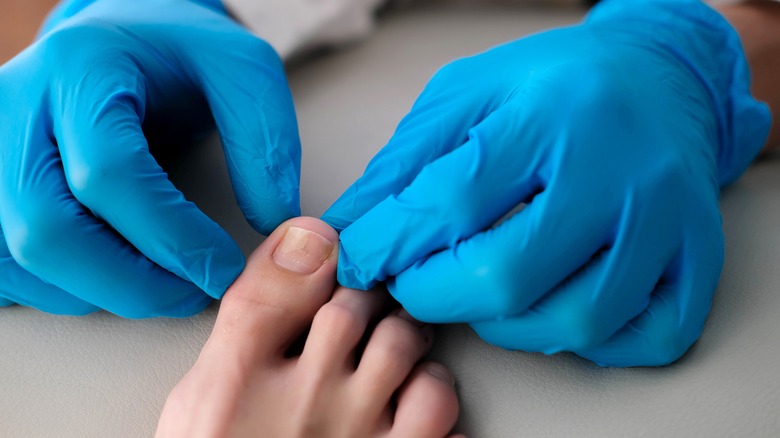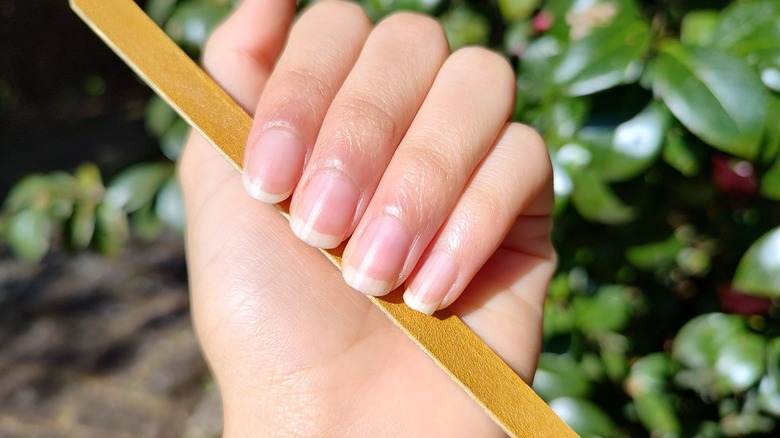Why Your Nails Should Always Be Included In Your Yearly Skin Check
When you think of nails, you probably think of nail designs or how to do your own acrylics at home. Nails have become a way for people to express their individual sense of style and character, as The Guardian points out, and celebrities like Rihanna and Katy Perry have made statements with their nail art that were memorable moments in their own right.
Your nails consist of the protein keratin, the same thing that's in your hair and skin, per Healthline, and their growth is dependent on several factors like the weather, which hand is the dominant one, stress, diet, and even your genes. While you may notice them more if you've ever had your nails done, or while clipping them, nails are a frequently forgotten part of the human body.
This shouldn't be the case, however. In fact, there is a major reason why your yearly skin check should include your nails as well.
Your nails are an important sign of your health
As dermatologist Dana Stern, MD, shared with Byrdie, "Sometimes people intentionally cover an ugly nail abnormality in order to cosmetically camouflage it," but this is a potentially dangerous idea especially when you're visiting your doctor for your yearly skin check-up. What may seem, on the surface, like insignificant color changes or bumps in odd places could actually be indicators of an underlying health condition (via WebMD).
For instance, pale nails might mean you have a poor diet, yellow fingernails could indicate a fungal infection or even lung disease and pitted nails might be telling you to watch out for psoriasis or inflammatory arthritis. Similar to how you might have experienced hair thinning because of illness or stress, our nails give hints too, as dermatologist Christine Poblete-Lopez, MD, told the Cleveland Clinic. Most notably, if you notice dark lines under your nails or a growth that's tender to the touch, this could be because of melanoma (a type of skin cancer), per the American Academy of Dermatology Association.
"Melanoma that comes from the nail unit is serious and can sometimes cause black lines or stripes to appear on the nail," skin expert and dermatologist John Anthony, MD, explained to Health. An annual examination of your skin usually rules out any possible risk of cancer, Dr. Darlene Gou, MD, of Innovative Dermatology confirmed. Your doctor will generally check areas like your palms, soles, scalp, and under the nails in order to be thorough.
There are several ways to keep nails healthy
Your lifestyle and daily habits could also be influencing your nails, as Health points out. Anything from stress to calcium deficiency, dehydration, overuse of nail products, and even applying and removing acrylic nails could be causing untold damage. Nail expert Eunice Park warned Byrdie, "Acrylic has bigger molecules than gel and therefore requires bigger grooves in the natural nail to grip onto — this is often why acid-based primers are used to etch the natural nail for acrylic."
This could be why your nails sometimes feel a bit painful after a visit to the salon. Likewise, your diet and how much water you drink matter too, according to dermatologist Christine Poblete-Lopez (via the Cleveland Clinic). A vitamin B, protein, and zinc-rich diet is ideal for optimal nail health. You should also throw in some omega-3 fatty acids and vitamin C for good measure, per Healthline.
Smoking severely alters the appearance of your nails as well, turning them a sickly yellow shade (via Harper's Bazaar). Although you don't have to stay away from nail polish completely, give your nails a break every now and again, as Everyday Health advises. Investing in a pair of gloves for when you tackle the dishes, do gardening, or even clean the bathrooms will also help keep your talons happy.


